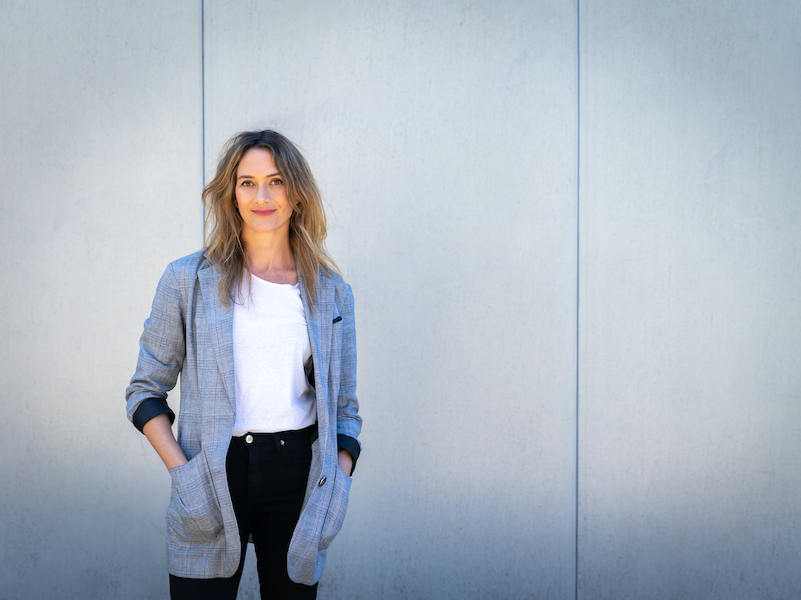Researcher Highlights
Visualising the landscapes of our future
Beth George
Dr Beth George’s award-winning architectural research explores the transformation of spaces, the history of architecture, and how we can honour the built environment we inhabit.

Dr Beth George’s research is as diverse as it is creative, encompassing teaching and writing around urbanism; teaching, practising, writing and exhibiting architectural drawing; and more. Beth also works as a sole practitioner in architecture, helping to reimagine and repurpose spaces to suit families’ and communities’ evolving needs.
However, Beth explains that her research isn’t exclusively focused on creating physical solutions. There is beauty and power in the process of making architecture, she says, long before any bricks are laid.
“There is no getting around architecture’s obligation to serve not just humanity, but whole ecologies and systems in the current geological age of the Anthropocene.
“There are manifold ways in which architects can act to ameliorate disaster and challenges associated with issues such as climate refuge and mass housing, providing lateral solutions from the minute to the vast.
“However, I don’t see architecture as a problem-solving activity. To me, architecture’s beauty and its power lie in comprehending, exploring and wrestling with problems, and in the artefacts and processes that are exposed when this endeavour is engaged with wholeheartedly.”
Mapping new possibilities
Beth’s PhD work explored the mapping processes that allow architects to imagine and articulate new opportunities. These processes often stem from cities’ actuality, she explains, and their distinctive, if sometimes peculiar, nature.
“My PhD work was about uncovering architectural possibilities for cities through careful and rigorous mapping processes. The research project has given me a lifelong interest in cartography and drawing, and in urbanism as a means to define and elaborate differences in cities.”
Building on her PhD work, Beth began exploring the broader role of communication in her field, including the spoken, written and drawn. She explains how effective communication underpins every step in the design process, from the initial investigations and recommendations for a space, to sketching new concepts and creating in-situ drawings.
“Communication is important when we make ‘readings’ of cities and develop propositions for them. It also allows us to draw our projects from ideas, and the individuals they are for, and make images about an intention. I have recently begun to investigate collaborative drawing practices, seeking an attunement between individuals in the cultivation of shared work.”
Restoring former glory
Beth is proud to see her award-winning research projects contribute to community development. Over the years, she has gained plenty of experience transforming disused urban infrastructure into vibrant and functional spaces that encourage collaboration and innovation. She has also driven urban projects that act as business incubators and generators for urban liveliness.
“For example, I ran a business that paired empty spaces with tenants, generating activity in ailing urban realms and enabling the fostering of young businesspeople and creative practitioners.”
Yet Beth’s work is far from confined to urban revitalisation. Beth received the coveted Peter Overman Award for Residential Architecture – Houses (Alterations and Additions) in the 2020 WA Architecture Awards for her project transforming an existing house built in 1908 into a functional family home.
“‘Reed House’ balances the dignity of the existing historic house, while simultaneously incorporating a modern material palette and sculptural, robust form.”
Beth is always looking for new ways to enhance the built environment and enrich people’s lives, and this often involves collaborating with partners such as community groups and councils. The avid researcher is especially excited to see new life breathed into old and new buildings across Newcastle—and welcomes local partnerships for future research.
“I’m interested in the possibility of engaging with voided territories here in Newcastle. I am also fascinated by the work being done at the University of Newcastle around resilience in post-industrial cities, including our own, but also others worldwide.”
A framework for the future
Beth’s research work provides immense inspiration for students at the University of Newcastle, motivating many of her students to explore urbanism from fresh perspectives.
As a senior lecturer, Beth is only too happy to nurture students’ curiosity, provide guidance across exploratory and communications work, and encourage her students to develop skills in a broad range of media, both digital and manual.
“It’s great to see students who are now encouraged to look at urbanism as a tool for cultivating distinctiveness in cities and places. They may go on to design structures and environments that influence people’s lives in a direct way.”
This drawing and design teacher also regularly contributes to the global research community through exhibitions, design competitions and written work like book chapters, journal articles and conference papers. Whether she is investing in global research dialogues, guiding students at the University of Newcastle or getting lost in her drawings, Beth’s work is always infused with raw creativity—and a passion for bringing new concepts to life.
“There is a flow that emerges in all aspects of design, whether in making marks on a page, writing words, or during conversation. There is nothing more exciting than feeling like what you are working on is beginning to take on a life of its own.”
The University of Newcastle acknowledges the traditional custodians of the lands within our footprint areas: Awabakal, Darkinjung, Biripai, Worimi, Wonnarua, and Eora Nations. We also pay respect to the wisdom of our Elders past and present.